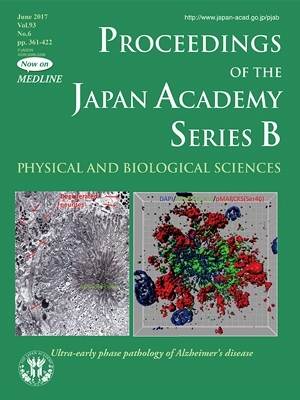About the Cover
Vol. 93 No. 6 (2017)
In the article published in this issue (pp. 361-377), “Ultra-Early Phase pathologies of Alzheimer’s disease and other neurodegenerative diseases,” the author, Hitoshi Okazawa, describes some of the key findings from his recent research that shed light on the Ultra-Early Phase pathology of Alzheimer’s disease and other neurodegenerative diseases. His findings strongly indicate that important pathologies do occur prior to the more commonly recognized abnormal aggregation of mutant proteins/peptides. For example, neurite degeneration occurs as one of the Ultra-Early Phase pathologies due to phosphorylation of MARCKS (myristoylated C-kinase substrate) at serine 46 (pSer46MARCKS), which is then followed by wide-scale gene expression changes. In this cover figure, a comparison is made between an electron micrograph of an amyloid plaque (left) and multiple immunohistochemical stainings (right). The immunohistochemistry shows co-staining of amyloid-beta and pSer46MARCKS. The pSer46MARCKS stains are also found in the degenerating neurites surrounding the amyloid aggregates. Some of the key molecules the author found in the common cascade of neurodegeneration that occurs prior to protein aggregation are now under development for therapeutic applications. For example, HMGB1 (high mobility group box 1), a DNA damage repair molecule gene, inserted into the AAV vector, and also a human antibody to prevent MARCKS phosphorylation are now being produced at the factory production level in the Japan Agency for Medical Research and Development (AMED) projects and will hopefully go into the clinical trial phase within 5 years.
Member of the Japan Academy
These figures are reproduced from Fujita, K. et al. (2016) Sci Rep. 6, 31895 and Graham D. I. and Lantos P. L. (eds.) (2002) Greenfield’s Neuropathology Seventh Edition, Volume II, Arnold, by permission of the copyright owners.




